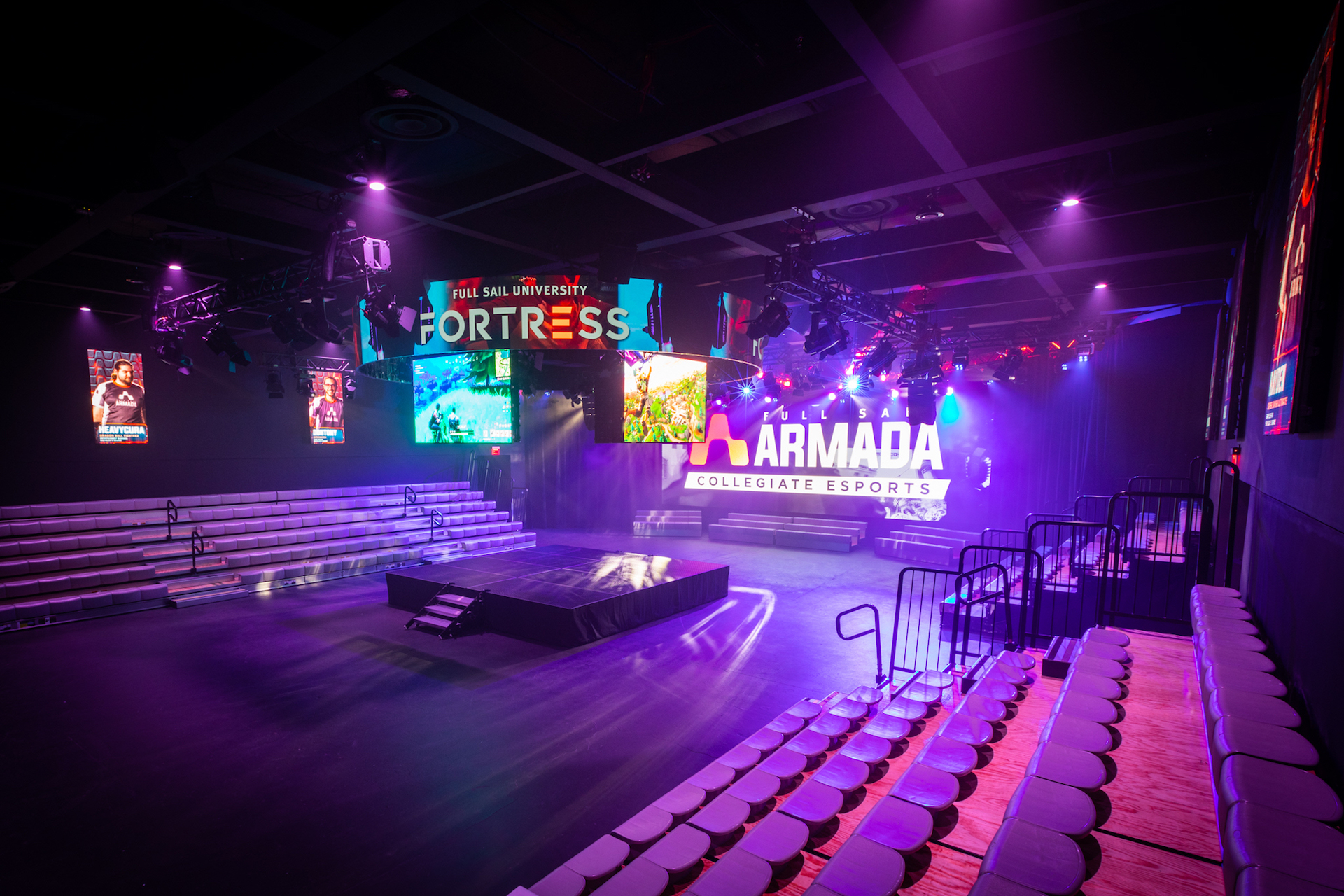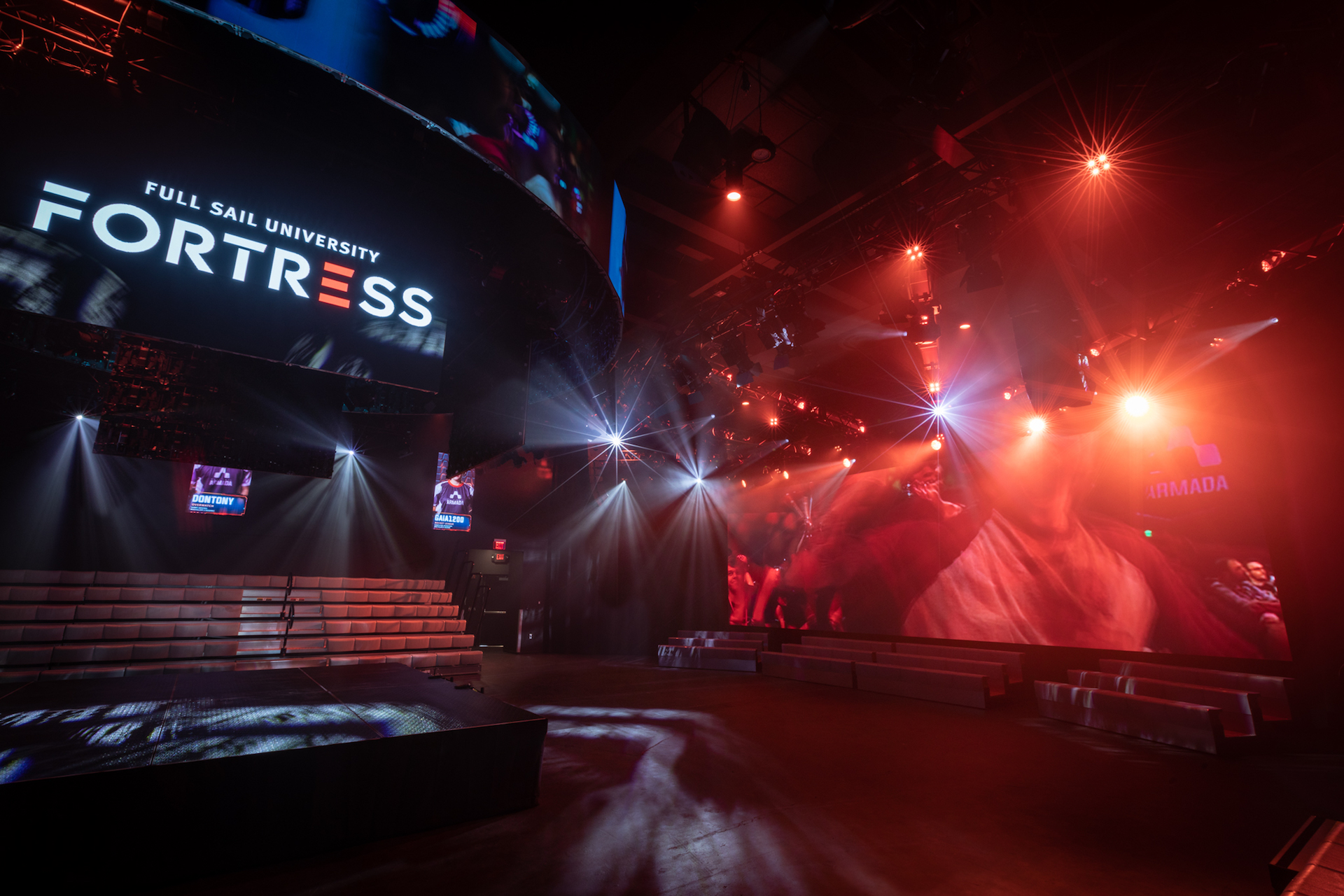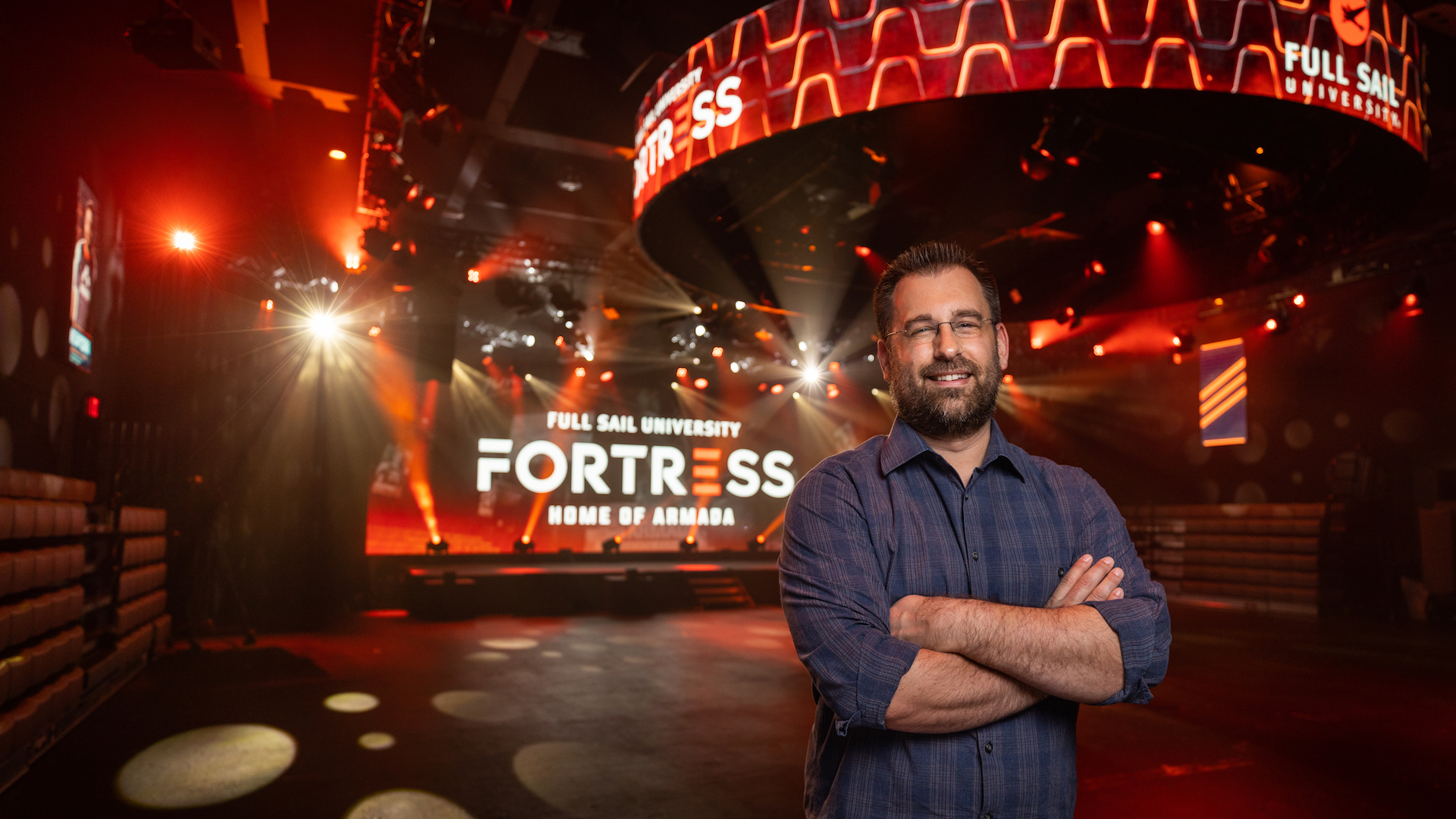Thousands of people across the country sit transfixed on their screens as the star player makes one last effort to lead his team to victory. Then, in an instant, the packed arena erupts with exuberant lights and music and the students in the bleachers go wild. The hero of the night stands up from behind his computer and acknowledges the crowd.
With all of the bells and whistles of a top-tier sporting venue, The Fortress, Full Sail University’s new competitive video gaming arena, provides an esports experience unmatched by any college. Located on the university’s Winter Park, FL campus, this 11,200-square-foot, 500-seat space is packed with massive LED displays, concert-level lighting and sound systems, and the capability to stream out feeds of the action to audiences around the world. And overseeing all of this technology is Vince Lepore, Full Sail’s director of event technical operations.
“The experience of watching esports in the Fortress as a spectator is second to none, but our students get to experience these events from behind the scenes, working with industry professionals to produce every aspect of the event,” Lepore said. “In that sense, the Fortress is one of the most unique esports environments on any college campus in the country.”
Envisioning the Space
One of the fastest-growing entertainment industries of the past few years, esports is taking the world by storm. With estimates of a global viewer base of more than 400 million and revenues expected to crack the $1 billion threshold this year, it’s a force the technology world can no longer afford to ignore. And among the college-age demographic, there are few pastimes that match its draw—and this is especially true at Full Sail, a school with one of the most prominent video game design programs in the country.
Last year, the university set out to create a dedicated home for its competitive gaming team, known as the Armada. Lepore, who has been working at Full Sail for close to 15 years—including as a course director teaching audio, video, and lighting design and show production—was involved in the project from the outset.
“I was involved from day one and all the way through the entire build-out,” he said. “I coordinated on the Full Sail side, alongside our internal design and technical teams, all of the design and installation of the audiovisual technology and the lighting.” According to Lepore, there were a few challenges to begin with. First, the venue was being constructed within the walls of an existing building that formerly served as a sound stage. Second, despite its purpose as a gaming arena, the facility still needed to accommodate a variety of configurations needed for the various esports events that it was designed to host.
“We knew from the outset that the building needed to be as flexible as possible,” Lepore said. “This has really proven to be true for us because of the varied nature of all the esports events that we do: some of them are 1v1, some of them are 5-on-5, some of them we do an end-stage configuration, and some of them we do in the round.”
Lepore said that a lot of visitors remark that the room resembles a black box theater. “And in a lot of ways it is; all of our staging is portable and can be reconfigured for various staging needs,” he said. “We put a lot of time and effort into the structure so that we could rig trusses, LED walls, and lighting in a wide variety of configurations.”
Selecting the Tech
Working with Lepore, Full Sail staff, and the integration firm Pro Sound and Video, Full Sail outfitted The Fortress with a battery of advanced AV and lighting systems. Giving every spectator a clear view of the action is some 10 million pixels’ worth of direct-view LED panels. The most prominent of these are the 36-foot-wide by 11.5-foot-tall main display at the back wall and a 24-foot-diameter center-hung LED ring.
“When you walk into the space, the LED screens are really the visual centerpiece, they grab your eye right away,” Lepore said. “There’s a lot of lighting, but the LED walls are really the most important part. For watching gameplay, that’s incredibly important, and we spent a lot of time making sure that every seat in the house would be able to see gameplay properly—no obstructions, no lights hanging in the LED walls, things like that.” Lepore said that this wasn’t without its challenges, given the limited trim height of the existing building.
One noteworthy aspect of these displays is their uniformity: each one is composed of Absen PL2.9 2.9mm pixel pitch tiles. “Every LED tile in the space is identical—it’s all the same product,” Lepore said. “We’ve got hundreds and hundreds of PL 2.9 tiles. So, from a maintenance perspective and an operational perspective, all of the LED product is identical, so we don’t have different pixel pitches, we don’t have different manufacturers or products—it’s all the same stuff.”
To drive the LED displays, Lepore chose Green Hippo Karst+ Hippotizer media servers. “We’ve been using Hippos for as long as I can remember here at Full Sail, so it’s something we know is industry-standard technology that we’re well versed in using,” he said. “We use them on live shows for both internal and external clients.”

Between the servers and the displays is a Barco S3 processor. “Every pixel in the facility runs through the Barco on its way out to the LED wall processors, and that allows us to manage picture-in-picture windows anywhere in the space, so that’s an important part of our workflow,” Lepore said. Operation of the video is done through Ross Video equipment and software, including a 3M/E Carbonite Black production switcher and Xpression graphics.
For audio, The Fortress employs L-Acoustics Kiva II line arrays, as well as X12 speakers and SB15 subwoofers. An eight-channel Shure Axient wireless system handles miking needs throughout the space. All of the audio systems run over a Dante network.
Connecting the Network
With all of the intense gaming going on inside—and with no tolerance for lag—one might expect the requirements for the network would be extreme. “That was actually something that we spent a considerable amount of time on because we wanted to make sure that we were future-proofing ourselves to the greatest extent that we could,” Lepore said. A Cisco house, Full Sail went with Cisco network switches. For internet connectivity, the facility currently has a dedicated 1Gbps link. “So far, with The Fortress primarily dealing with streaming out to the internet, having a dedicated 1Gbps up and down link has been more than sufficient for what we need.”
Naturally, the network is isolated from the Full Sail main network. “There’s a couple touchpoints between them, but overall we built an isolated production network that would stand alone from everything else,” Lepore said. “Essentially, what we have is a core layer of switches and an access layer of switches. It’s fully redundant, so if one of our core switches were to fail, it would fail over to the secondary core. And the network is pretty well segregated, even internally, so we’re using typical stuff: a bunch of VLANs to separate, for example, Dante traffic from video traffic, from staff and guests and all the different things that we do.”
Tech Teamwork
Of course, managing a facility like this requires smooth cooperation from various departments—especially IT. “We’ve got a great IT team here that supports all of the networking gear, which is actually a really big deal,” Lepore said. “I dabble enough in networking to be dangerous with it, but at the level we’re doing this you really need dedicated IT staff. One of the nice things about being an organization like Full Sail is we have that IT team in place already, so they were able to help us with this, and that’s been great.”
Running the Show
Since opening in May, The Fortress has hosted a number of large events, including an NBA2K tournament in June. “That was a huge show and it really took full advantage of what we had put in place,” Lepore said. This month, it will also host the Hearthstone Collegiate Championships. For large events like this, the external clients bring their own resources and production staff. “Our team is engineering the building, and they’re pretty much manning all of the operational roles,” Lepore said.
But for 75 percent of the events at The Fortress, it’s a fully in-house production. “We manage it from end to end,” Lepore said. “We bring in any staff or freelancers that need to come in to operate the show, we bring in rental gear, we develop the whole run of show, we stream it ourselves and staff all of the positions.”
Most notably, many of these positions are filled by students learning media production. “Everything that we do here is for our students, we’re a university,” Lepore said. “So, the internal events have a lot of positions manned by students or operated by students.” According to Lepore, staff or freelancers will typically take on the key roles critical to the production. “Then we have students who are either shadowing those people or they’re filling some of the other operational roles, like camera operators, for example, or video shader, or audio assist, or A2 or L2—that type of thing. That’s one of the things that’s unique about what we do.”
Sharing the Magic
In keeping with the popularity of competitive gaming, The Fortress live streams many of the events it hosts, both on Twitch and on Full Sail’s channels, including YouTube. According to Lepore, these can reach audiences ranging in size from tens of thousands of viewers to just a few hundred, depending on the event. “We had a Super Smash Bros. tournament this past weekend where we had up around 1,000 people watching at any given time, but that was a pretty small event for us,” he said.

However, Lepore said that streaming is a relatively small component of the production work and something that he’s not deeply involved in. “I don’t really deal with that too much; We have people on our IT staff that handle all of the streams that come out of Full Sail’s campus. I hand them a produced feed with video and program audio and they take it from there,” he said.
His main responsibility surrounding streaming is ensuring the systems are redundant so that the streams can be as resilient as possible. “Because at the end of the day that’s how we’re delivering our content,” he said. “What’s the point of doing these shows if we can’t be 100 percent sure that that stream is going to go out? For some of the stuff that we do here, we have satellite trucks that come in if it needs to be more robust, but most of the time we’re running computers with Wirecast or OBS, and that’s how we’re streaming out to the world.”
Staying Fresh
In addition to The Fortress, Lepore also oversees the audiovisual technology inside Full Sail Live, which he describes as the “flagship live facility on campus.” Now nine years old, Full Sail Live hosts weekly broadcasts of WWE wrestling on the USA Network and serves as a venue for larger events like concerts, conferences, and the hosting the university’s graduation ceremonies. “It’s a little bit larger than The Fortress and we’ve done gaming events in there as well,” he said. “It’s another multipurpose live event facility on campus.”
Given its busy schedule, Full Sail Live presents an ongoing challenge for Lepore and his team. “We’re in the process of doing a lot of renovations from an AV perspective,” he said. “It’s not that it’s not functional anymore; there’s just newer and better things. And what we do in these buildings has evolved over the years, so we’re constantly doing upgrades any chance that we get.”
And such opportunities for work are minimal, given its use for weekly national television broadcasts. “When you’re doing that and you’re on that schedule, say, 50 weeks a year, when do you do these sorts of upgrades?” he said. “Well, what you have to do is strategically plan them in: ‘OK we can do some work on Monday and Tuesday, we can do some work on Friday, but we can’t work on Wednesday or Thursday because we’re doing the show.’ It’s a constant evolution and a constant process.”
Parting Advice
This continuous process of improvement is something Lepore enjoys. Even though The Fortress is less than a year old, he has already been considering ways in which it can be improved. “We’ve identified some things where we said ‘Oh, I wish we had done that; I think we still need to do this, this, and this; we need to get a couple more of these,’” he said. “So we’re already starting that process and looking forward to the next year or two.”
Still, despite his focus on technological refinement, for Lepore, the gear is secondary. “You could have all the gear in the world—and at Full Sail we are very fortunate: we truly do have all of the gear in the world—if you don’t have the people to operate it and you don’t have the team behind it, it just doesn’t work,” he said.
And in this case, a people-first focus has the added benefit of cultivating a new generation of AV and broadcast professionals.
“Having been at Full Sail for a long time—I was in education here for 14 years before I took on this role—it’s really rewarding to have students learn while working side by side with you, and this type of stuff that we’re doing, esports, they’re really excited about it,” Lepore said. “It’s a really exciting time to be doing these things and the students love it.”

